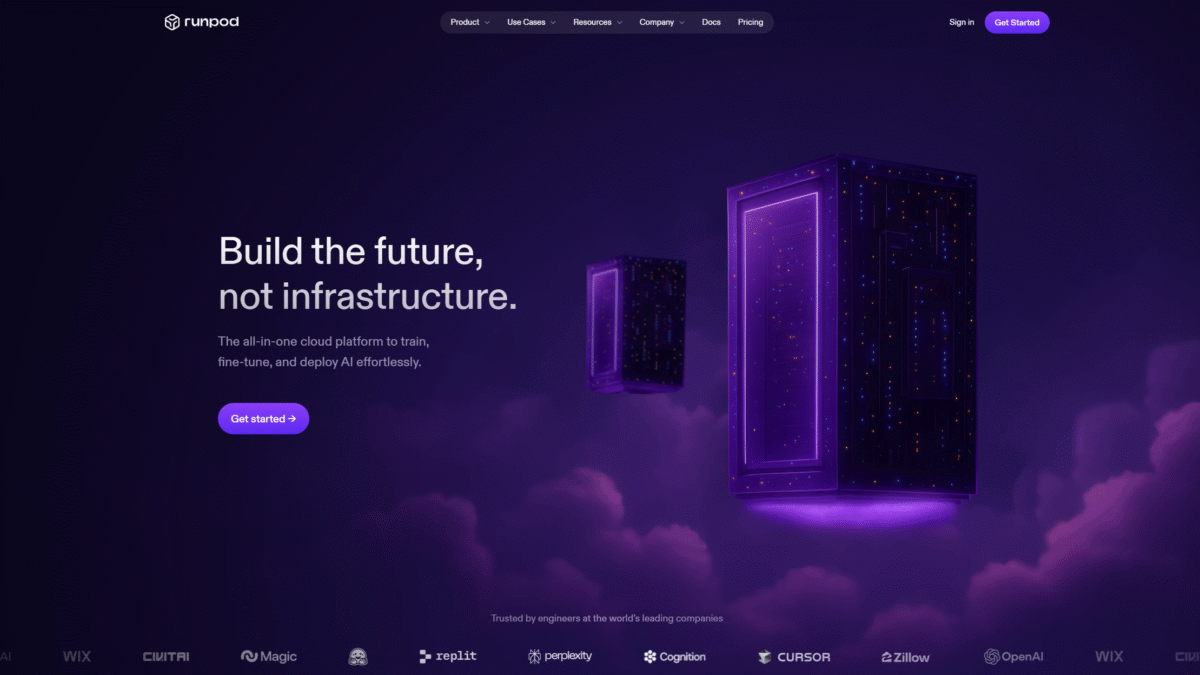
Deep Learning Servers Go Serverless: Scale GPUs Instantly
Searching for a flexible deep learning server solution that scales GPUs instantly? With Runpod, you can spin up powerful GPU pods in milliseconds and pay only for what you use. Whether you’re training large language models or serving real-time inference, the serverless approach transforms how your teams deliver AI applications.
Why Traditional Deep Learning Servers Fall Short
On-premise or reserved GPU instances often leave you waiting through long cold-boots, overpaying for idle capacity, and wrestling with complex infrastructure. These legacy setups can stall development sprints, prolong model tuning cycles, and inflate operational costs—particularly when workloads spike unpredictably.
In contrast, a serverless GPU model lets you deploy and scale your deep learning server workloads on demand. No more standing up entire clusters for a single experiment, and no more wasted compute hours when usage drops.
How Serverless GPU Pods Work
Serverless GPU architecture abstracts away underlying nodes. You define your container and resource requirements, then let the platform handle provisioning, autoscaling, and load balancing. As requests arrive, GPU workers spin up within milliseconds; when demand subsides, they scale back to zero—ensuring you only pay for actual usage.
- Instant provisioning: Pods cold-boot in under 250 ms.
- Autoscaling logic: Scale from 0 to hundreds of GPUs in seconds.
- Transparent billing: Metered per second, no ingress/egress fees.
Key Benefits of a Serverless Deep Learning Server
- Cost Efficiency: Eliminate idle-time charges by paying only when your GPUs process data.
- Rapid Iteration: Start experiments in seconds, not minutes—accelerate research cycles.
- Global Footprint: Deploy in 30+ regions to minimize latency for end users worldwide.
- Simplified Operations: No cluster management, patching, or capacity planning overhead.
- Flexible Workloads: Train, fine-tune, and serve models in the same environment.
- Secure & Compliant: Enterprise-grade GPU instances with network security and access controls.
Runpod: The Cloud Built for AI
Runpod offers a globally distributed GPU cloud designed specifically for deep learning server workloads. Spin up GPU pods in milliseconds, choose from 50+ preconfigured templates or bring your own custom container, and leverage zero-fee ingress/egress across 30+ regions.
Train on NVIDIA H100s, A100s, or reserve AMD MI250s and MI300Xs in advance. When your models need inference at scale, switch to serverless endpoints with sub-250 ms cold-starts, autoscaling, and real-time analytics.
Essential Features for Every AI Workflow
1. Lightning-Fast Pod Launch
With Flashboot technology, GPU pods launch in under 250 milliseconds. Start coding in PyTorch, TensorFlow, or any custom container almost instantly:
- Instant cold-boots for experiments and debugging.
- Hot-reload CLI to iterate on code changes locally.
2. Serverless Inference Engine
Deploy models with autoscaling, job queueing, and sub-250 ms cold-start times. Ideal for unpredictable traffic patterns:
- Auto-scale workers from 0 to hundreds in seconds.
- Real-time usage, execution time analytics, and logging.
3. Flexible Container Support
Public or private image repos are supported, letting you configure any environment you need:
- Choose from managed and community templates.
- Bring your own Docker container for custom dependencies.
4. Network Storage Integration
Connect GPU workers to NVMe-backed network volumes with up to 100 Gbps throughput:
- Support for 100 TB+ on demand.
- High-performance I/O for data-intensive workloads.
Real-World Use Cases
Large Language Model Training
Researchers spin up clusters of A100 GPUs in seconds to pretrain or fine-tune LLMs. When experiments finish, the environment scales back automatically, ensuring no resource is wasted.
Computer Vision Inference
E-commerce platforms serve image classification or object detection models via serverless endpoints that adjust capacity in real time, handling holiday traffic spikes without manual intervention.
Data Science Collaboration
Teams share templates and containers in a private repo, ensuring consistency across development, staging, and production environments—all managed through a single pane of glass.
Getting Started Is Fast and Easy
- Create a Runpod account and authenticate your CLI.
- Choose a template or upload your custom container.
- Define GPU specs and networking options.
- Launch your deep learning server pod or serverless endpoint.
- Monitor usage and performance through the dashboard or API.
Get Started with Runpod Today and experience GPU scaling without the ops headache.
Best Practices for Serverless GPU Workloads
- Optimize your model for inference latency—batch requests where possible.
- Use usage analytics to right-size GPU allocations.
- Leverage spot-priced GPUs for non-peak training jobs.
- Cache frequently used data on network storage volumes.
- Implement CI/CD pipelines to automate container builds and deployments.
Conclusion
In today’s fast-moving AI landscape, the traditional deep learning server model simply can’t keep up with variable workloads and cost constraints. Serverless GPU architecture from Runpod lets you spin up powerful compute in milliseconds, automatically scale to meet demand, and pay only for what you use. From large-scale model training to low-latency inference, Runpod covers all your AI infrastructure needs without tedious operations or surprise fees.
Get Started with Runpod Today and transform your AI projects with instant GPU access and global reach.
